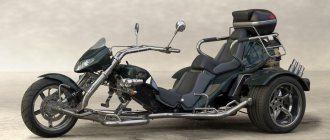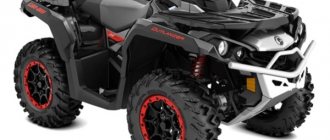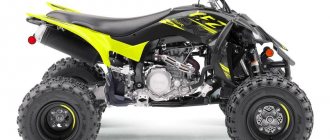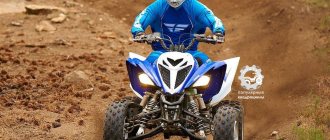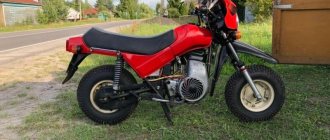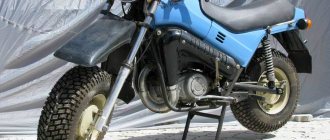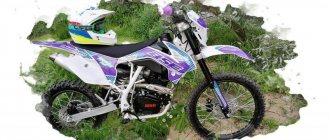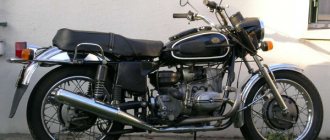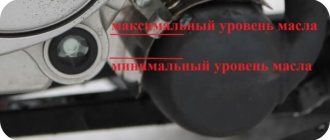The Yamaha P1 was first introduced to the world in 1998. Over this fairly long period, many restylings and updates were carried out. The wheelbase, power, center of gravity, etc. have been modernized, but only one thing remains unchanged - the high quality of the model.
Since its creation, the motorcycle has consistently been included in all sportbike ratings. And now the model is the flagship among racing motorcycles from the Yamaha brand. It harmoniously combines stylish design and advanced technological achievements. Many experts believe that the bike is now the leader among vehicles in its class.
Design
In the case of the Yamaha R1, the photo does not convey all the grace of the motorcycle. A swift silhouette, born after numerous aerodynamic tests, a predatory squinting of the headlights... It seems that the bike is not driving along the road, but is flying over it. Perhaps this is so, if you remember what speed he is capable of developing. Over the past twenty-odd years, it has changed noticeably in appearance, but both old and new Yamaha P1s look very stylish .
Motorcycle design
The R 1 bike looks very stylish and modern. The pointed “pike” muzzle immediately catches your eye. LED headlights with reflective coating add additional audacity and aggression to the vehicle. The saddle is slightly raised (1.5 centimeters), and the steering wheel is also slightly higher. The new dashboard looks even more attractive than before. The design is completed by a powerful titanium exhaust pipe, which ends in two mufflers.
It will also be interesting: How Minsk motorcycles were born and what they came to
In general, the model looks impressive and spectacular - everything you need for a high-end sports bike. Photos of the Yamaha P1 serve as confirmation of this.
Specifications
When designing the new flagship, Yamaha engineers went all out, offering customers a bike designed for the race track. Since then it has been constantly improved and modified, and the latest generations do not have much in common with the first, but they are united by the use of advanced technologies at the time of release, so that the technical characteristics of the motorcycle always remain at the highest level.
Engine
All generations are equipped with a liquid-cooled engine (4 cylinders) , first with a carburetor, and then with an injector. Power depends on the specific model, over time it has increased from 150 to 200 hp. , and the power output of the Yamaha YZF R1 exceeded 1 hp. per 1 kg of mass. The engine capacity did not change - 998 cubic centimeters . The maximum torque has changed, but only slightly, from 108 to 112 Nm . Modern examples have a top speed of 300 km/h with acceleration from 0 to 100 km/h in 2.8 seconds .
Transmission
All modifications of the YZF R1 are equipped with a gearbox-6 with a quickshifter , which helps to change gears. By the way, they are quite long, and even on the first one you can accelerate to 90-100 km/h, although you shouldn’t do this regularly - the engine won’t say “thank you”.
Chassis and brakes
The chassis is made of high-strength aluminum alloy, and in 2002 engineers first used the new Deltabox . It turned out to be very successful, and the overall rigidity of the frame increased by 30% . about the braking system , except that they are close to ideal . No wonder the brakes from the R1 were subsequently installed on many other models of the company. From a technical point of view, they are almost perfect, and the ABS system makes them even more reliable.
Electronics
The motorcycle has enough of it - an electronic throttle grip, an electronic YCC-T throttle, Öhlins electronic suspensions (on the R1M version) ... This all complicates independent repairs, and in most cases you have to contact qualified motorcycle services that have the necessary equipment.
Weight and dimensions
The fresher the bike, the more it weighs. The first copies of the Yamaha YZF had a dry weight of 198 kg , and for the latest, newest ones, this parameter increased to 206 kg . You can feel it statically, but once you start moving, the bike immediately begins to seem light as a feather. And thanks to its compact dimensions, it can easily squeeze between cars in city traffic jams.
Controllability
What can you expect from a flagship sportbike designed to win on the track? If you think it should steer perfectly, then you're right. But there is a downside to this - an incorrect or untimely reaction can lead to a fall, since the Yamaha P1 reacts very sensitively to the slightest twist of the throttle or turn. But thanks to the huge reserve of power, it does not pay attention to the presence or absence of a passenger, and no matter how much the pilot weighs - this bike doesn’t care, it is able to rush towards the horizon in a few seconds.
Fuel consumption
The Yamaha P1 does not have a moderate appetite. The consumption declared by the manufacturer reaches 6.9 liters per 100 km , and with aggressive driving it can be even higher. The tank volume is 18 liters (or 17, depending on the generation), and the sportbike prefers the AI-98. You can safely pour AI-95 into old carburetor units.
Motorcycle price
The cost depends on the year of manufacture and condition. A new bike from a dealer will cost about 1.8 million rubles , and an ancient R1 from 1998-2000 can be found on the secondary market for 180-200 thousand . But it’s better to look at options from 2003 and older, since in 2002 the carburetors were replaced with an injector, and a year later the company eliminated all minor defects. And connoisseurs of a more recent design who do not have the budget for a new motorcycle can pay attention to the Yamaha YZF R1 2007 or younger - that’s when a deep restyling was carried out.
Driving impressions
Yamaha YZF-R1
While the Yamaha R1 may not have the prestige of some European competitors, it is still one of my favorite sportbikes (on the track, of course. On the road it's a pain). Few models can compete with the divine melody of the R1's offset ignition when it sings in full voice, and with the new electronic throttle the engine response to the throttle has become even better - essentially, which is the point of the cross-shaped crankshaft.
If you're familiar with the latest Yamaha YZF-R1, the 2022 model won't seem too new. Starting the day with the base model, I quickly felt familiar and comfortable, even though I hadn't driven one in a couple of years. And I hadn’t been to this track for more than 10 years, so I started with a familiarization lap, which the R1 did very well.
Let me note a few points.
First, I already talked about this - I really appreciated the instant response of the rear wheel to movements with my right hand. The Yamaha YZF-R1 produces great traction, but it's completely controllable (assuming you're not a beginner - the R1 is definitely not for beginners). Yamaha representatives didn't point this out, but the revs, especially in riding modes 1 and 2 (the two most bouncy and powerful), are much smoother than on other Yamahas I've tested. Personally, I preferred mode 2 for its slightly less aggressive kick at the start.
Yamaha YZF-R1 2020
The second thing is damn nice confidence in every sense: the Bridgestone R11 corners superbly (the stock R1s will be shod with RS11s) at any angle available to me, and the feedback is clear and understandable both from the tires and from the chassis as a whole.
Third, I relied on electronic assistants, and they did not disappoint. Ten years ago, when I last visited this track, I was riding a Ducati 1098R with the first traction control fitted to a production motorcycle. And although this was a nice bonus, it was more of a road bonus - on the track it interfered too obviously and tediously, constantly cutting off traction and making it difficult to complete the lap as quickly as possible. Ten years later, the electronic features on the Yamaha R1 are barely noticeable. This is the best evidence of how far we have come, and it makes us look forward to the further development of these technologies.
At the end of my third and final ride (which was the sixth for the bike, since we alternated in the saddle), I felt that I began to ride confidently, but the bike, on the contrary, was tired. Or rather, the tires are tired: the side support has dropped considerably. In one of the simple corners, it was necessary to open the gas as early as possible in order to get out of it as quickly as possible onto the straight, but on worn tires this led to a serious breakdown - and I would be happy to say that my skills saved me, but praise the perfect work of the traction control. control will be more honest.
Yamaha YZF-R1
Thinking back to 2015, when the first version of today's Yamaha R1 first appeared, I can clearly imagine how the adjustable wheelie control allowed the front wheel to rise under load and then smoothly return to the track. Everything remains roughly the same on the Yamaha YZF-R1 in 2022, and you especially feel it coming out of the narrow hairpin at the end of the lap. You come out of the last corner at full throttle, and really ride on the back foot. The lift control works, and you can directly feel how it is trying to figure out how much traction to provide so that you move forward, but not lift the front wheel too much. I shift up and the front lands. Personally, being able to use the gas without fear gives me a kind of serenity that allows me to go faster. It should be noted that I was driving in lift control mode No. 2. The first mode leaves the rider more control, and the braver guys I've talked to turn off the lift control altogether and work with their head, not just their right hand.
If we talk about the weak points of the Yamaha R1, then these are again the brakes. Braking power is decent and response is better, but I want more. More braking force, more sensitive initial braking and LESS ABS! Sometimes heavy braking and three quick downshifts activate the ABS for no apparent reason, especially on the rear wheel, which once forced me to go very wide and completely miss the turn.
Yamaha R1M
Yamaha R1M
I switch to the Yamaha R1M saddle on Bridgestone V02 slicks this afternoon and the impressions are... basically the same. This shouldn't be surprising, given that the main difference between the two is in the suspension. However, there is still a noticeable difference between conventional and semi-active suspension: when you load the fork with powerful braking, you feel how the electronic suspension reacts and adjusts, providing greater stability and support during braking. And all this - in a split second. The same goes for the rear suspension during acceleration.
The real difference in sensations begins when you get off the Yamaha R1M and start downloading telemetry logs. In the application on your phone you can see a huge number of parameters for driving each circle. There are 16 different data layers that show throttle percentage, GPS speed, gear engaged, and where and when the driver's aids were engaged, all overlaid on a graph and Google Maps track map. This truly is a new level of analysis for those outside of the factory racing teams.
Yamaha R1M 2020
Repair and tuning
Due to its complex design, it is not easy to repair the bike yourself, although this does not interfere with maintenance. But if problems arise, it is better to contact a motorcycle service center.
Repair
The Yamaha YZF-R1 is a difficult motorcycle to repair. To get to any part, you may have to scatter half the bike in the corners of the garage, removing the plastic, gas tank, exhaust and something else. And modern generations are equipped with so many electronics that diagnostics require a connection via a bus, and, accordingly, a laptop with special software.
Spare parts
They are not cheap. In the event of a minor breakdown, the owner will not go broke, but the average price of spare parts for a Yamaha P1 will be higher than for a Honda CB 400 or Suzuki GSX-R600.
Tuning
There are many upgrades available, there are tons of them in one official Yamaha catalog. A carbon body kit instead of the usual plastic, new exhausts , gearbox feet, grips, mirrors... If only we had the money, the motorcycle could be turned into a real monster. In a good way!
Motorcycle modifications
The model appeared in 1998, but the first modification was discontinued already in 1999. Already in 2000, the first restyling took place, and in 2002 the third generation, equipped with an injector, went into production. The following restylings took place in 2004, 2006 and 2007, but during this time no significant changes were made. On the secondary market, by the way, there are plenty of 2004 R1s at affordable prices - especially many fourth-generation copies were produced.
There were no noticeable changes in 2008 either, and the 2011 R1 became the last version of the sportbike without built-in traction control. 2015 was marked by the release of a new modification, the Yamaha YZF R1M, and at the same time the production of the eighth generation, the latest at the moment, began. Since then, there have been no changes, with the exception of a few small things, and the Yamaha P1 2022 or 2022 is practically no different from its counterparts released several years earlier.
Yamaha R1M
Yamaha R1M 2020
The Yamaha R1M features more carbon fiber, updated electronics, and the latest Öhlins ERS electronic racing suspension. Like the base Yamaha R1, the M was not radically updated, but became a development of the current version. It features the latest edition of Öhlins' NPX ERS fork with updated algorithms and a gas reservoir in the fork body - a first on a production motorcycle, according to Yamaha. Like the standard R1, the spring rate is slightly reduced from 21 N/mm to 20 N/mm. Structurally, the NPX fork is not much different from conventional forks - springs, sets of washers, valves, but the valves here have a real-time electronic drive, which makes the fork semi-active. The ERS monoshock has also been slightly retuned to match the fork, with a new compression piston, different valving settings and a 4mm increase in spring preload for a slightly higher rear end lift.
As before, the standout feature of the Yamaha R1M is the Communications Control Unit (CCU) , which allows the rider to change the R1M's settings using the YRC app and see how well (or poorly) it rides using the Y-TRAC app, now available on iOS. The CCU records data from the GPS, inertia measurement device and engine ECU, allowing 16 channels of telemetry to be analyzed from each lap of the track - essentially providing a watered-down version of the data a race team needs to help their driver go faster. If you ride with a faster mate on another R1M, you can compare data from both sportbikes and highlight the strengths and weaknesses of both riders.
The Yamaha R1M also received a new front fairing, fender, side hood and tail - all made of carbon - emphasizing the exclusive appearance of the M version, and the emblem on the airbox is now numbered.
Advantages and disadvantages
To produce the YZF R1, Yamaha used all the technologies available to it, so the disadvantages of the sportbike stem from its advantages.
Advantages
- Crazy acceleration dynamics . Not a single ultra-expensive sports car can compare with the Yamaha P1 in this regard.
- Great brakes . They have become a real standard in the world of motorcycles.
- Stylish and recognizable design . Even those bikers who have never ridden anything other than a Ural know what this model looks like.
- Refined handling . This is especially noticeable on the track.
Flaws
- Engines on first-generation specimens are prone to oil starvation if their horizon changes, so the motorcycle is not very suitable for a stunt.
- At the bottom the bike behaves nervously, reacting sharply to the slightest change in the throttle position.
- It is not easy to maintain and repair modern YZF-R1s yourself, and all operations at dealers are expensive.
Owner reviews
It was the Yamaha P1 that showed me where adrenaline comes from)) After the meeting with the seller, I took the bike and went home, I had never experienced such sensations in my life. At first it was scary to drive around the city; turn the handle sharply 1/5, and there is a risk of flying into a pole or car. The motorcycle is crazy, I'm delighted. Dmitry, Moscow.
I switched from the CBR 600, which was the second of my three sports, I didn’t want to change my beloved Honda, but I fell in love with Erku at first sight. The characteristics are crazy, the comfort is so-so, but it looks so that the number of passers-by turning their heads at it is in the dozens every day, and these are only those whom I myself notice. R1 is the king of sportbikes! Sergey, Krasnodar.
At first I drove a 1998 YUZF R1, the motor I received was damaged, a month later the motor died - the valves were bent. I used it for spare parts, and for the next season I bought the same one, but 2008. It feels like you’re sitting on the same motorcycle, only the instrumentation has become prettier, and the character of the engine has become more friendly, not so harsh, smart electronics prevent you from making a mistake. But the power hasn’t gone away, the acceleration is such that it pulls you back across the seat. Vasily, St. Petersburg.
FAQ
- What is the maximum speed of the bike? 300 km/h for the latest generations, and a little less for the first.
- What kind of gasoline should I use? Carburetor versions can use 95. It’s better to fill the injection ones with 98, although the bike can also work on pure 95, but it’s better not to take risks.
- How many cubes are there in it? Thousand? No, the engine volume has never changed - 998 cc.
- In what year did they start installing injectors? In 2002.
- Is it heavy? Does it have a lot of weight? I had a cruiser that weighed 350kg, can I handle a Yamaha R1? Subjectively, the motorcycle does not seem heavy, but it weighs about 200 kg, give or take, depending on the generation.
Yamaha YZF-R1 Video
We present to your attention a well-assembled selection of rides on this motorcycle, which well demonstrates all its capabilities.
In the hands of a professional, a motorcycle can do incredible things. And the right music will make viewing even more enjoyable. As one popular character in a Hollywood movie said, “You are either mad or a genius. These are two extremes of the same essence." The hero of the next video clip is just balancing on the brink. Perhaps it would even be possible to publish this video under the hashtag “Dementia and Courage”, if not for the professionalism of this motorcyclist.
In a word, see for yourself, decide for yourself. Carefully! It's breathtaking to watch.
Did you like the article? Tell your friends!
Comments (3)
- liz1990:
03/11/2015 at 03:36In fact, I have always respected this particular motorcycle manufacturer. In my opinion, this company is the most reliable. It produces truly high-quality and durable equipment.
Answer
- Dima:
05/24/2015 at 02:54
I also have enormous confidence in this company)) They really rarely break down. I started with the Joga 50cc, which broke down least often)) Now I ride on the indestructible YBR 125))
Answer
- Dmitriy:
08/15/2016 at 20:13
Ground clearance 136 cm - correct
Answer
Conclusion
The Yamaha YZF R1 is not a motorcycle for everyone. It requires the pilot to have honed control skills, nerves of steel and lightning-fast reactions. To ride such power, you first need to ride something calmer for more than one year. This bike is intended for experienced motorcyclists who can tame a wild beast, while beginners risk that it will simply throw them off in a turn. Great power requires great responsibility - we are not alone on the roads.
Specifications
| Maximum engine power: | from 150 to 200 HP |
| Torque: | from 108 to 112 Nm Nm |
| Working volume: | 998 cm3 |
| Motor type (cylinder arrangement, number of strokes): | 4-stroke, liquid-cooled, forward-leaning inline 4-cylinder |
| Number of cylinders: | 4 |
| Number of valves: | |
| Intake type (Injector / Carburetor): | |
| Bore and stroke: | |
| Starting system (Electric starter, kick starter): | |
| Maximum speed in km/h: | 300 km/h |
| Cooling system: | Liquid cooling |
| Transmission (gearbox): | 6 |
| Clutch (Dry / Wet): | |
| Drive unit: | Chain |
| Frame: | aluminum, diagonal |
| Chassis | |
| Suspension (front/rear travel): | |
| Brakes (Front/Rear): | |
| Wheels / Tires / Rubber: | |
| Dimensions and weight | |
| Dimensions (Length / Width): | |
| Seat height: | |
| Ground clearance: | |
| Curb weight: | |
| Wheelbase: | 1405 mm |
| Weight: | 198-206 kg |
| Fuel tank capacity: | 17-18 l. |
| Battery capacity: | |
| Year of release: | |
| Country of Origin: |
What you need to know about the model
The high quality of the Yamaha YZF R1 is visible in the details . For example, you can adjust the parameters of the bike with one light touch. Thanks to this, the driver can easily enter even the most difficult turns, which can significantly reduce the speed of completing a lap on the race track.
The aluminum diagonal frame is lightweight and has good strength. It greatly simplifies the process of driving a vehicle. Using the six-mode TCS traction mechanism, you can adjust the injection parameters, which has a positive effect on the power of the model. At the same time, the motorcycle behaves perfectly in any climatic conditions.
The braking system is also good. she demonstrates excellent performance. There is a double-disc hydraulic brake with a diameter of 310 mm at the front, and a single hydraulic disc at the rear with a diameter of 220 mm.
We can talk about the advantages of the R1 model for a very long time - and even in a few hours you cannot describe all its main advantages.
Video of a cool test drive of the Yamaha R1 sports bike:
